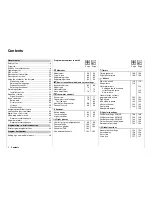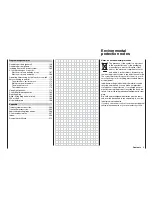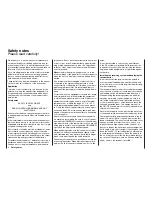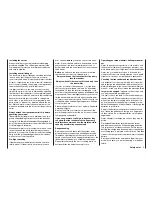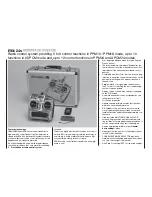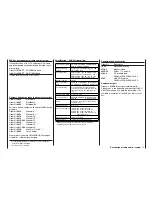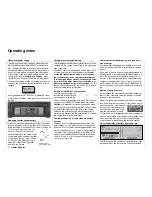
We all want you to have many hours of pleasure in
our mutual hobby of modelling, and safety is an im-
portant aspect of this. It is absolutely essential that
you read right through these instructions and take ca-
reful note of all our safety recommendations.
If you are a beginner to the world of radio-controlled
model aircraft, boats and cars, we strongly advise
that you seek out an experienced modeller in your
fi eld and ask him for help and advice.
These instructions must be handed on to the new ow-
ner if you ever sell or dispose of the transmitter.
Application
This radio control system may only be used for the
purpose for which the manufacturer designed it, i.e.
for operating
radio-controlled models
which
do not
carry humans
. No other type of use is approved or
permissible.
Safety notes
SAFETY IS NO ACCIDENT
and
RADIO-CONTROLLED MODELS ARE NOT
PLAYTHINGS
Even small models can cause serious personal inju-
ry and damage to property if they are handled incom-
petently.
Technical problems in electrical and mechanical sys-
tems can cause motors to rev up or burst into life un-
expectedly, with the result that parts may fl y off at gre-
at speed, causing series injury.
Short-circuits of all kinds must be avoided at all times.
Short-circuits can easily destroy parts of the radio
control system, but even more dangerous is the acu-
te risk of fi re and explosion, depending on the circum-
stances and the energy content of the batteries.
Propellers (aircraft and boat), helicopter rotors, open
gearboxes and all other rotating parts which are dri-
ven by a motor or engine represent a permanent in-
jury hazard. Do not touch these items with any object
or part of your body. Remember that a propeller spin-
ning at high speed can easily slice off a fi nger. Ensu-
re that no other object can make contact with the dri-
ven components.
Never
stand in the primary danger zone, i. e. in the
rotational plane of the propeller or other rotating parts,
when the motor is running or the drive battery is con-
nected.
If an internal-combustion engine or electric motor is
connected to the system, take great care to avoid
any possibility of it bursting into life when you are pro-
gramming the transmitter. We recommend that you
disconnect the fuel supply or the drive battery before-
hand.
Protect all electronic equipment from dust, dirt, damp,
and foreign bodies. Avoid subjecting the equipment
to vibration and excessive heat or cold. Radio control
equipment should only be used in “normal” ambient
temperatures, i. e. within the range -15°C to +55°C.
Avoid subjecting the equipment to shock and pressu-
re. Check the units at regular intervals for damage to
cases and leads. Do not re-use any item which is da-
maged or has become wet, even after you have dried
it out thoroughly.
Use only those components and accessories which
we expressly recommend. Be sure to use only genui-
ne matching
GRAUPNER
connectors of the same de-
sign with contacts of the same material. If you are still
using plug-in crystals, use only genuine
GRAUPNER
crystals on the appropriate frequency band.
When deploying cables note that they must not be un-
der tension, and should never be bent tightly or kin-
ked, otherwise they may fracture. Avoid sharp edges
which could wear through the cable insulation.
Check that all connectors are pushed home fi rmly be-
fore using the system. When disconnecting compon-
ents, pull on the connectors themselves – not on the
wires.
It is not permissible to carry out any modifi cations
to the RC system components. Avoid reverse polari-
ty and short-circuits of all kinds involving the connec-
ting leads, as the equipment is not protected against
such errors.
Installing the receiving system and deploying the
receiver aerial
In a model aircraft the receiver must be packed in
soft foam and stowed behind a stout bulkhead, and
in a model boat or car should be protected effectively
from dust and spray.
The receiver must not make contact with the fuselage,
hull or chassis at any point, otherwise motor vibration
and landing shocks will be transmitted directly to it.
When installing the receiving system in a model po-
wered by a glowplug or petrol engine, be sure to in-
stall all the components in well-protected positions
so that no exhaust gas or oil residues can reach the
units and get inside them. This applies above all to
the ON / OFF switch, which is usually installed in the
outer skin of the model.
Secure the receiver in such a way that the aerial, ser-
vo leads and switch harness are not under any strain.
The receiver aerial is permanently attached to the re-
ceiver. It is about 100 cm long and must not be shor-
tened or extended. The aerial should be routed as far
away as possible from electric motors, servos, me-
tal pushrods and high-current cables. However, it is
best not to deploy the aerial in an exactly straight line,
but to angle it: e. g. run it straight to the tailplane, then
leave the fi nal 10 - 15 cm trailing freely, as this helps
to avoid reception “blind spots” when the model is in
the air. If this is not possible, we recommend that you
lay out part of the aerial wire in an S-shape inside the
model, close to the receiver if possible.
Safety notes
Please read carefully!
4
Safety notes
Summary of Contents for mx-24s
Page 1: ...1...
Page 19: ...19 For your notes...
Page 35: ...35 For your notes...
Page 41: ...41 41 For your notes...
Page 57: ...57 For your notes...
Page 63: ...63 63 For your notes...
Page 69: ...69 69 For your notes...
Page 85: ...85 85 For your notes...
Page 99: ...99 For your notes...
Page 143: ...143 For your notes...
Page 191: ...191 For your notes...
Page 212: ...212 212 For your notes...
Page 213: ...213 213 For your notes...
Page 214: ...214 For your notes...
Page 216: ...216...


